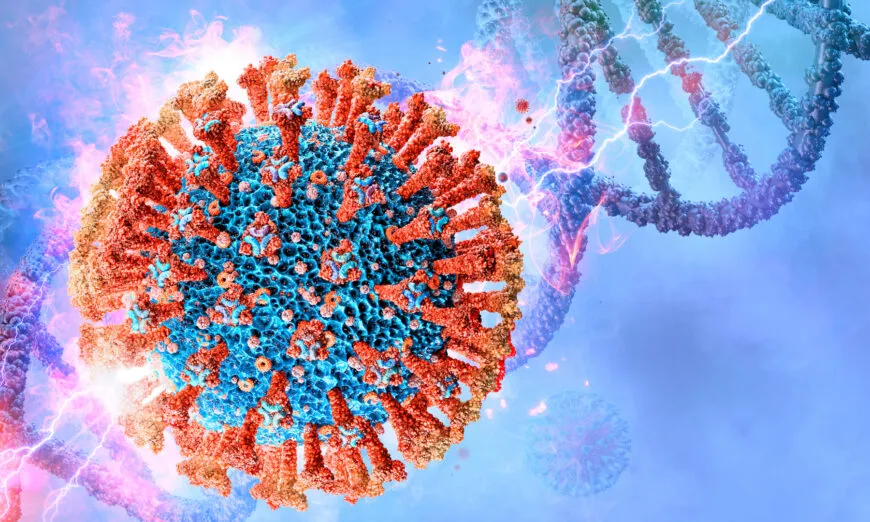One criticism of the rushed, mass-COVID vaccination project was that running mass vaccinations in the middle of an active pandemic was not just unusual — most vaccination programs are designed to prevent outbreaks before they happen — but dangerous. Because, the argument went, doing so would force the virus’ natural inclination to evolve into overdrive. Hence, some claimed, the seemingly endless parade of new variants.
As it turns out, another Covid drug may be culpable in supercharging the evolution of new Covid variants.
Researchers at the Francis Crick Institute, the University of Cambridge, Imperial College London, the University of Liverpool, the University of Cape Town and UKHSA have uncovered a link between an antiviral drug for COVID-19 infections called molnupiravir and a pattern of mutations in the SARS-CoV-2 virus.
In fact, Molnupiravir is designed to force the virus to mutate.
Molnupiravir works by inducing mutations in the virus’s genetic information, or genome, during replication. Many of these mutations will damage or kill the virus, reducing viral load in the body. It was one of the first antivirals available on the market during the COVID-19 pandemic and was widely adopted by many countries.
“Many of these mutations” is not, of course, “all of these mutations”. But did Molnupiravir actually work as planned? The evidence suggests so.
In research published in Nature today, the scientists used global sequencing databases to map mutations in the SARS-CoV-2 virus over time. They analysed a family tree of 15 million SARS-CoV-2 sequences so that at each point in each virus’s evolutionary history they could see which mutations had occurred.
Although viruses mutate all the time, the researchers identified mutational events in the global sequencing database which looked very different to typical patterns of COVID-19 mutations, and that they were strongly associated with individuals who had taken molnupiravir.
These mutations increased in 2022, coinciding with the introduction of molnupiravir. They were also more likely to be seen in older age groups, consistent with the use of the antivirals to treat people who are more at risk, and in countries which are known to have high molnupiravir use. In England, the researchers analysed treatment data and found that at least 30% of the events involved use of molnupiravir.
The causes of mutational events can be traced by looking at their ‘mutational signature’: a preference for mutations to occur at particular sequences in the genome. The researchers found a close match between the signature seen in these mutational events and the signature in clinical trials of molnupiravir.
Fortunately, though, the mutations triggered by Molnupiravir seem nothing like the gain-of-function weaponisation carried out in Wuhan, which may have created the virus in the first place.
The researchers also saw small clusters of mutations which suggests onward transmission from one person to another, although no established variants of concern are currently linked to this signature.
News Medical – Life Sciences
So, is this something we need to be worried about?
Lead author Theo Sanderson […] a geneticist at London’s Francis Crick Institute, emphasised that there is no evidence that “molnupiravir has to date created more transmissible or more virulent viruses”.
None of the variants that have swept the world were due to the drug, he added. But “it is very difficult to predict whether molnupiravir treatment could potentially lead to a new widely circulating variant which people don’t have prior immunity to,” he added.
On the other hand, manufacturer Merck is very keen to pooh-pooh the research.
Merck refuted the study, saying the researchers had relied on “circumstantial associations” between where and when the sequences were taken.
“The authors assume these mutations were associated with viral spread from molnupiravir-treated patients without documented evidence of that transmission,” Merck said in a statement sent to AFP.
Sanderson rebuffed this claim, saying the researchers had used “several independent lines of evidence to identify with confidence that molnupiravir drives this mutational signature”.
SBS
Other virologists backed Sanderson’s research, calling it an “incredibly important, well-conducted piece of research”.
So, what’s the upshot of it all?
Well, as Sanderson admits, we don’t really know. Yet. But it’s an important insight into how even treatments for diseases can have knock-on effects that must be taken into account when considering a cost-benefit approach.
Or, to put it more bluntly: rushing medications to market is not the best idea.









